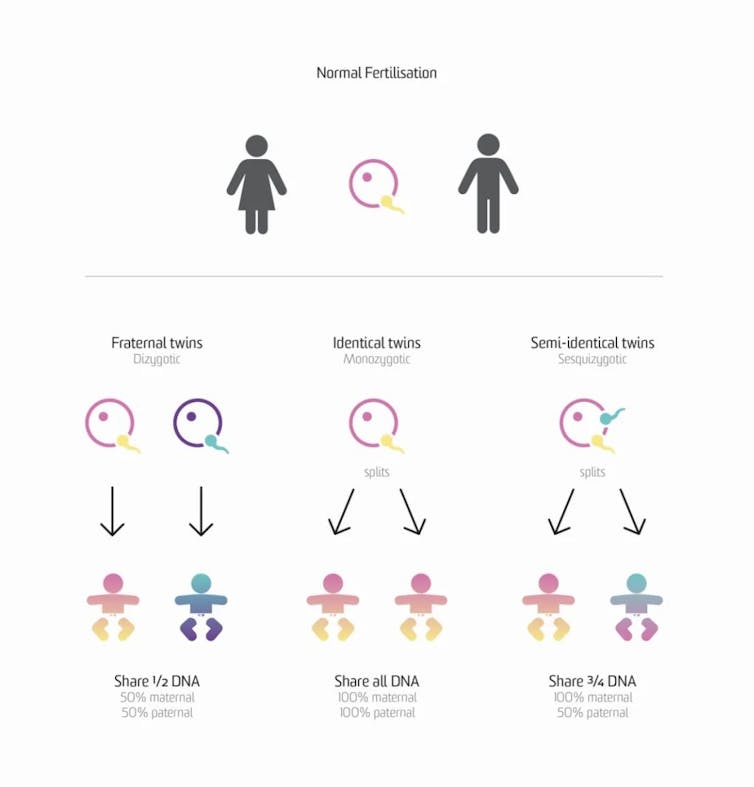when identical twins are non-identical
- Written by Hannah Brown, Postdoctoral Research Affiliate, University of Adelaide
We all know a set of twins; perhaps even a set of identical twins. In Australia, twins account for about one in 80 births.
But in research published today in the New England Journal of Medicine, we learn of a very unique set of Australian twins.
A boy and a girl from Brisbane, aged four, have been identified as only the second set of semi-identical, or sesquizygotic twins, in the world. They are the first to have been observed in utero (in the womb).
This extremely rare phenomena is the result of two sperm fertilising the same egg.
Read more: Seeing double: why twins are so important for health and medical research
How do twins occur?
The most common type of twins are non-identical twins, which can be the same or different sexes. Non-identical twins are also known as fraternal twins or dizygotic twins (from two zygotes, what we call the earliest embryo when the egg and sperm fuse).
This type of twinning occurs when more than one egg is released from the ovary at ovulation (normally just a single egg is selected and released), and both of the eggs are fertilised by different sperm. These twins are no more genetically similar than siblings born years apart.
The rates of non-identical twins differ between groups: it’s about eight in 1,000 in caucasian populations, 16 in 1,000 in African populations, and four in 1,000 in people of Asian decent. This suggests there is a genetic component to non-identical twins.
Read more: Explainer: twins, triplets, quadruplets and more
Identical twins (also known as monozygotic – originating from one zygote) are less common. They are the product of just one egg and one sperm, which originally form one embryo, but which break into two during the earliest stages of pregnancy. Scientists are continuing to explore how this occurs biologically, but the process remains a mystery.
The rate of identical twins is consistent across the globe at about four in 1,000 births. This suggests it’s probably just a random biological phenomena not influenced by genetics.
 There are three different genetic configurations possible in human twins.
UNSW
There are three different genetic configurations possible in human twins.
UNSW
Prior to today, there was only one reported case of a third type of twins – semi-identical twins.
In 2006, twins in the US were identified as semi-identical twins when they were examined as infants for another medical condition. They too were the result of one egg fusing with two sperm.
But now we know the Queensland siblings are the second set of twins to fall into this mysterious and fascinating category.
What are semi-identical twins?
Scientists believe semi-identical twins are the result of one egg allowing two sperm in simultaneously (which has previously been thought to be non-viable, meaning a pregnancy would never occur).
In the case reported in today’s research, the pregnancy was identified as twins at six weeks. The ultrasound showed they shared a placenta, which is common to 70% of identical twins.
But at 14 weeks of pregnancy, tests revealed the twins were non-identical – one was a girl and the other a boy. Ordinarily non-identical twins would have their own placenta. They were an anomaly.
Thorough DNA testing has revealed they are identical on the maternal side (confirming they came from just one egg, like identical twins). But they are more like non-identical twins on the paternal side, sharing only a proportion of their father’s DNA.
Read more: How twins like the Scott brothers distinguish themselves in battle
Scientists understand biologically how the DNA of our mother and father mix to create an embryo (and subsequently a baby). On the day the egg and sperm meet in the fallopian tube, the DNA, packaged into chromosomes, divides equally into two, allowing the baby to inherit one copy of information from mum and one from dad.
When this doesn’t go to plan, a baby may get too many or too few chromosomes, resulting in genetic disorders like Down Syndrome (an extra copy of Chromosome 21). This may also result in a pregnancy which is not viable.
We still don’t know a lot
There is no scientific precedent for how one embryo manages to separate three sets of chromosomes, as is the case in semi-identical twins. This may remain a scientific mystery.
We have no idea how similar these twins are going to look, although the best guess is that they will be like every other set of non-identical, fraternal twins.
As they are just the second case of this type of twins ever identified, it’s hard to know if they will have a special connection beyond their extra shared DNA.
A search by researchers through huge databases of twins across the globe failed to find more semi-identical twins, suggesting this type of twinning is very rare.
Discoveries like this that teach us just how much there is still to learn about biology and health, and how fascinating the world of reproduction and pregnancy is.
Authors: Hannah Brown, Postdoctoral Research Affiliate, University of Adelaide
Read more http://theconversation.com/same-same-but-different-when-identical-twins-are-non-identical-112684



